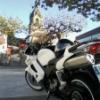The people who more time use the VTEC region (above 7000 rpm) is who more BBQs celebrates . I.e.: people who ride a lot on track, fast in the road, etc: Auspañol , Kepa , Valen, etc. . People who ride calmly with motorcycle breaks less: el_Jau , me, etc. . This is statistical , but why ?
The alternator is heated by two phenomena :
1 - . The copper losses , which depend on the intensity of the current supplied (Amperes) .
2 - . The iron losses, that are frequency dependent and this increases with rpm.
I've taken some electrical measurements on the yellow wires from the output of the stator.
This is the current flowing in said wires to different rpm ( = copper losses ) :
Rpm -> E ( V ) -> I ( A)
1200 -> 12.7 -> 20
5000 - > 10 -> 30
7000 -> 10.2 -> 31
This is the frequency of the voltage and current generated by the 12 poles alternator at different rpm ( = the iron losses)
rpm -> f (Hz )
1200 -> 120
5000 -> 500
7000 -> 700
Nothing new: more rpm -> more heat that we have to evacuate of the alternator. The proposals that have been done here are very interesting. We'll see how they work.
My new proposal to use "shunt regulator" is as follows :
1 - To Reduce power consumption 1/3 by using LED.
2 - To Use a battery of 14 Ah .
3 - To Install a monitoring system to measure and control, in real time onboard, the state of charge (SOC) of the battery: How about Arduino microcontrollers?
4 - The control system will disconnect the alternator from 100% to 60% of the SOC. The bike will run only with battery. This will allow the cooling of the windings in the stator: we will not have copper losses.
6 - When the SOC = 60 % , connect, with a relay, the alternator and charge the battery and feed the rest of the bike systems .
The idea would be just to use the alternator at intervals and not all the time. To see who dares to develop
Vss

